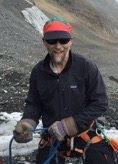The Early Years- First Greenland season
My Taylor Dome season had been a once-in-a-lifetime opportunity to go to Antarctica. It'd given me an interest in the polar regions and fed my desire to go back one day. I thought, though, that it'd be a while before another opportunity like that came up. Imagine my surprise, then, when Gary Clow of the United States Geological Survey sent me an email in the spring of 1996. I had worked with Gary at Taylor Dome, and he was gearing up to go to Summit, Greenland, the location of the GISP2 ice core, drilled over 3km to bedrock in the early 1990's.

A shot of Summit camp as it is today. You can see the yellow tents we sleep in. The main structure now has a satellite communications antenna which looks like a ball- in the old days we didn't have such luxuries...
Our goal was to log temperatures in the 3016-meter-deep main borehole, and to attempt a new technique to log temperatures in shallow boreholes. Because the shallow parts of an ice sheet are porous like snow, shallow boreholes will not hold fluid. For our temperature measurements, we wanted a fluid-filled hole, since air movement in the borehole can change the temperature the sensor feels, making measurement of the temperature of the ice difficult. For our new technique, we would lower a sealed pipe down the borehole, open at the surface. We would then fill the pipe with a special heat-transfer fluid. Since no borehole is absolutely vertical, the pipe would lie against the wall of the borehole, and the fluid in the pipe would come into thermal equilibrium with the ice. Air would be kept from moving in the hole by a "packer" that was installed about 10 meters deep in the hole, which we then filled in with snow, sealing it from the surface. Here's a shot of us lowering the pipe down the borehole. The black arching obhect is the pipe, made of a flexible plastic, intended initially for irrigation.

When I came back from that season, I wrote a report on the activities of the season, which I posted here in html.


0 Comments:
Post a Comment
<< Home